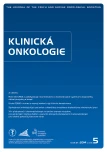Prognostic Markers of Advanced Non-small Cell Lung Carcinoma – Assessing the Significance of Oncomarkers Using Data-mining Techiques RPA
Authors:
S. Cingelova 1; V. Labudová 2; D. Berkešová 3; M. Dienerová 4; A. Dammak 4; E. Grmanová 4; O. Nádaská 4; I. Vasilenková 4; E. Najšelová 4; V. Skarbová 4; M. Migašová 4; Z. Viktorínová 4; Ľ. Jurga 4
Authors‘ workplace:
II. onkologická klinika LF UK a NOÚ, Bratislava, Slovensko
1; Fakulta hospodárskej informatiky, Ekonomická univerzita, Bratislava, Slovensko
2; AnalytX s. r. o., Trnava, Slovensko
3; Onkologická klinika FN Trnava, Slovensko
4
Published in:
Klin Onkol 2014; 27(5): 347-352
Category:
Original Articles
doi:
https://doi.org/10.14735/amko2014347
Overview
Introduction:
Identification of new prognostic factors can help in designing future clinical studies. In the case of advanced non-small cell lung cancer, there might be good candidates – tumor markers CYFRA 21-1, CEA or NSE [1–8]. It is possible to evaluate the relationship between their expression and prognosis by data mining technique recursive partitioning and amalgamation.
Patients and Methods:
We analyzed retrospective data of 162 patients of Oncology clinics in Trnava. All of these patients were admitted between 2008 and 2012 for the administration of first-line chemotherapy according to current recommendations. We evaluated the impact of known pretreatment prognostic markers – performance status, weight loss, smoking, age, sex, stage, histologic subtype, comorbidity and oncomarkers CYFRA 21-1, CEA or NSE, as well as combinations of these factors on survival.
Results:
Our analyses showed that there are three subgroups of patients with good, intermediate and unfavorable prognosis. Oncomarkers played an important role in formation of a subgroup of 49 patients with good prognosis – including patients with no pretreatment weight loss and low levels of CEA (≤ 4.1 ng/ml) or NSE (≤ 11.1 ng/ml). In this subgroup, the median survival time was at least 16 months (not achieved) and the difference in survival compared to the rest of the group was highly statistically significant (risk ratio 5.21, 95% CI 1.41–19.28; p < 0.0001).
Conclusion:
We showed the prognostic significance of low levels of NSE and CEA oncomarkers in the group of patients with no pretreatment weight loss. Recursive partitioning and amalgamation is a useful data mining method, but the generated hypothesis needs to be confirmed by further clinical study designed for this purpose.
Key words:
non-small cell lung cancer – oncomarkers – data mining – regression tree – neuron-specific enolase (NSE) – carcinoembryonal antigen (CEA)
The authors declare they have no potential conflicts of interest concerning drugs, products, or services used in the study.
The Editorial Board declares that the manuscript met the ICMJE “uniform requirements” for biomedical papers.
Submitted:
19. 3. 2014
Accepted:
25. 9. 2014
Sources
1. Molina R, Filella X, Augé JM et al. Tumor markers (CEA, CA 125, CYFRA 21-1, SCC and NSE) in patients with non-small cell lung cancer as an aid in histological diagnosis and prognosis. Comparison with the main clinical and pathological prognostic factors. Tumour Biol 2003; 24(4): 209 – 218.
2. Pujol JL, Boher JM, Grenier J et al. Cyfra 21 - 1, neuron specific enolase and prognosis of non-small cell lung cancer: prospective study in 621 patients. Lung Cancer 2001; 31(2 – 3): 221 – 231.
3. van Zandwijk N, Mooi WJ, Rodenhuis S. Prognostic factors in NSCLC. Recent experiences. Lung Cancer 1995; 12 (Suppl 1): S27 – S33.
4. Kulpa J, Wójcik E, Reinfuss M et al. Carcinoembryonic antigen, squamous cell carcinoma antigen, CYFRA 21 - 1, and neuron-specific enolase in squamous cell lung cancer patients. Clin Chem 2002; 48(11): 1931 – 1937.
5. Ferrigno D, Buccheri G, Giordano C. Neuron-specific enolase is an effective tumour marker in non-small cell lung cancer (NSCLC). Lung Cancer 2003; 41(3): 311 – 320.
6. Pujol JL, Molinier O, Ebert W et al. CYFRA 21 - 1 is a prognostic determinant in non-small-cell lung cancer: results of a meta-analysis in 2063 patients. Br J Cancer 2004; 90(11): 2097 – 2105.
7. Barlési F, Gimenez C, Torre JP et al. Prognostic value of combination of Cyfra 21-1, CEA and NSE in patients with advanced non-small cell lung cancer. Respir Med 2004; 98(4): 357 – 362.
8. Maeda T, Ueoka H, Tabata M et al. Prognostic factors in advanced non-small cell lung cancer: elevated serum levels of neuron specific enolase indicate poor prognosis. Jpn J Clin Oncol 2000; 30(12): 534 – 541.
9. Ciampi A, Hogg SA, McKinney S et al. A computer program for recursive partition and amalgamation for censored survival data. Comput Methods Programs Biomed 1988; 26(3): 239 – 256.
10. LeBlanc M, Crowley J. Relative risk trees for censored survival data. Biometrics 1992; 48(2): 411 – 425.
11. Terek M, Horníková A, Labudová V. Hĺbková analýza údajov. Bratislava: Iura Edition 2010 : 265.
12. Ciampi A, Lawless JF, McKinney SM et al. Regression and recursive partition strategies in the analysis of medical survival data. J Clin Epidemiol 1988; 41(8): 737 – 748.
13. Goldstraw P. IASLC Staging Manual in Thoracic oncology. USA: IASLC publication, Editorial ExPress 2009 : 157.
14. Oken MM, Creech RH, Tormey DC et al. Toxicity and response criteria of the eastern cooperative oncology group. Am J Clin Oncol 1982; 5(6): 649 – 655.
15. Jacot W, Colinet B, Bertrand D et al. Quality of life and comorbidity score as prognostic determinants in NSCLC patients. Ann Oncol 2008; 19(8): 1458 – 1464.
16. Zhang HP, Singer B. Recursive partitioning in the health sciences. New York: Springer 1999 : 223.
Labels
Paediatric clinical oncology Surgery Clinical oncologyArticle was published in
Clinical Oncology

2014 Issue 5
Most read in this issue
- Prognostic Markers of Advanced Non-small Cell Lung Carcinoma – Assessing the Significance of Oncomarkers Using Data-mining Techiques RPA
- Breast Cancer Patient Satisfaction with Immediate Two-stage Implant-based Breast Reconstruction
- Cereblon – a New Target of Therapy in the Treatment of Multiple Myeloma
- Pomalidomide in the Treatment of Relapsed and Refractory Multiple Myeloma
